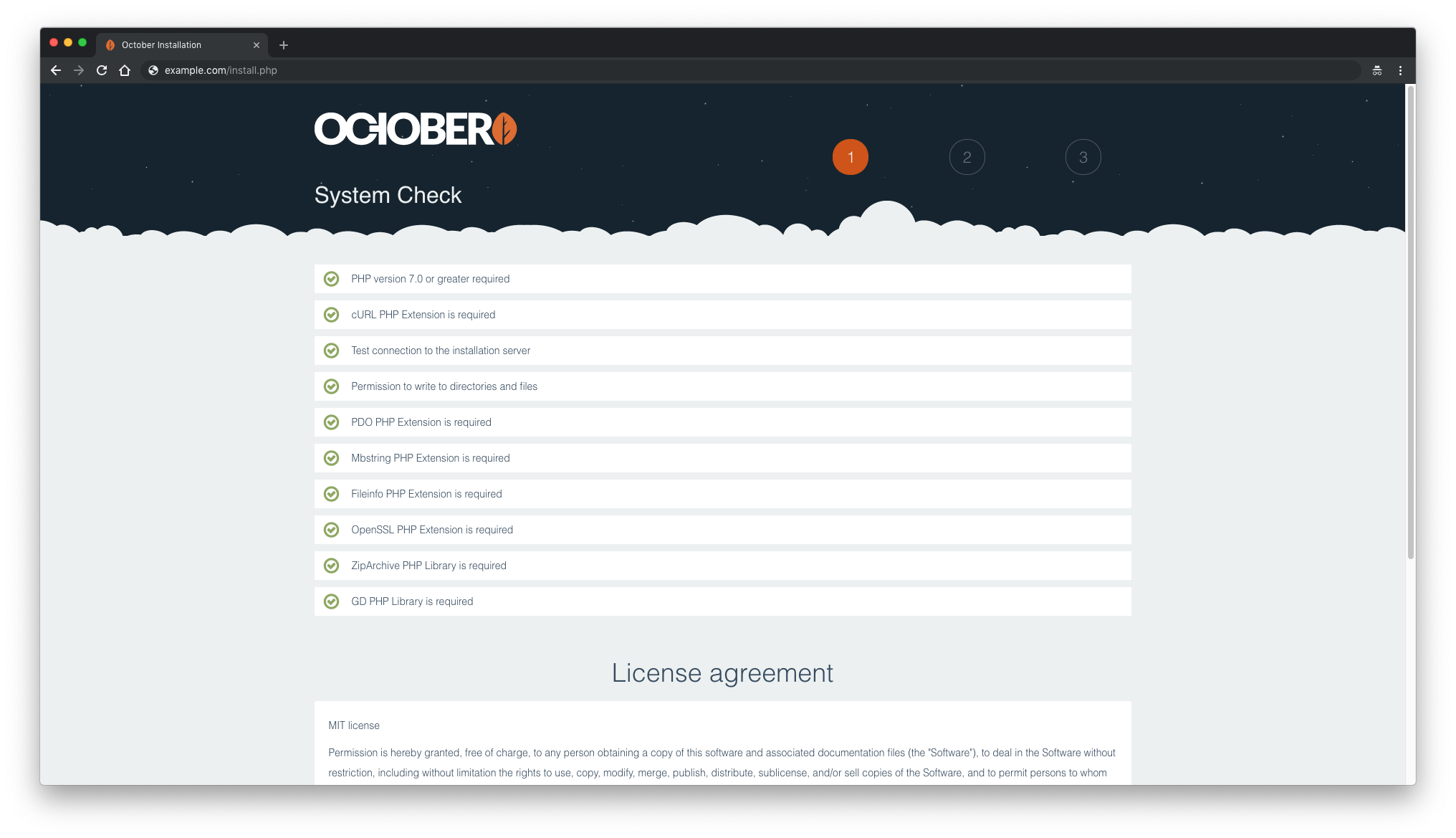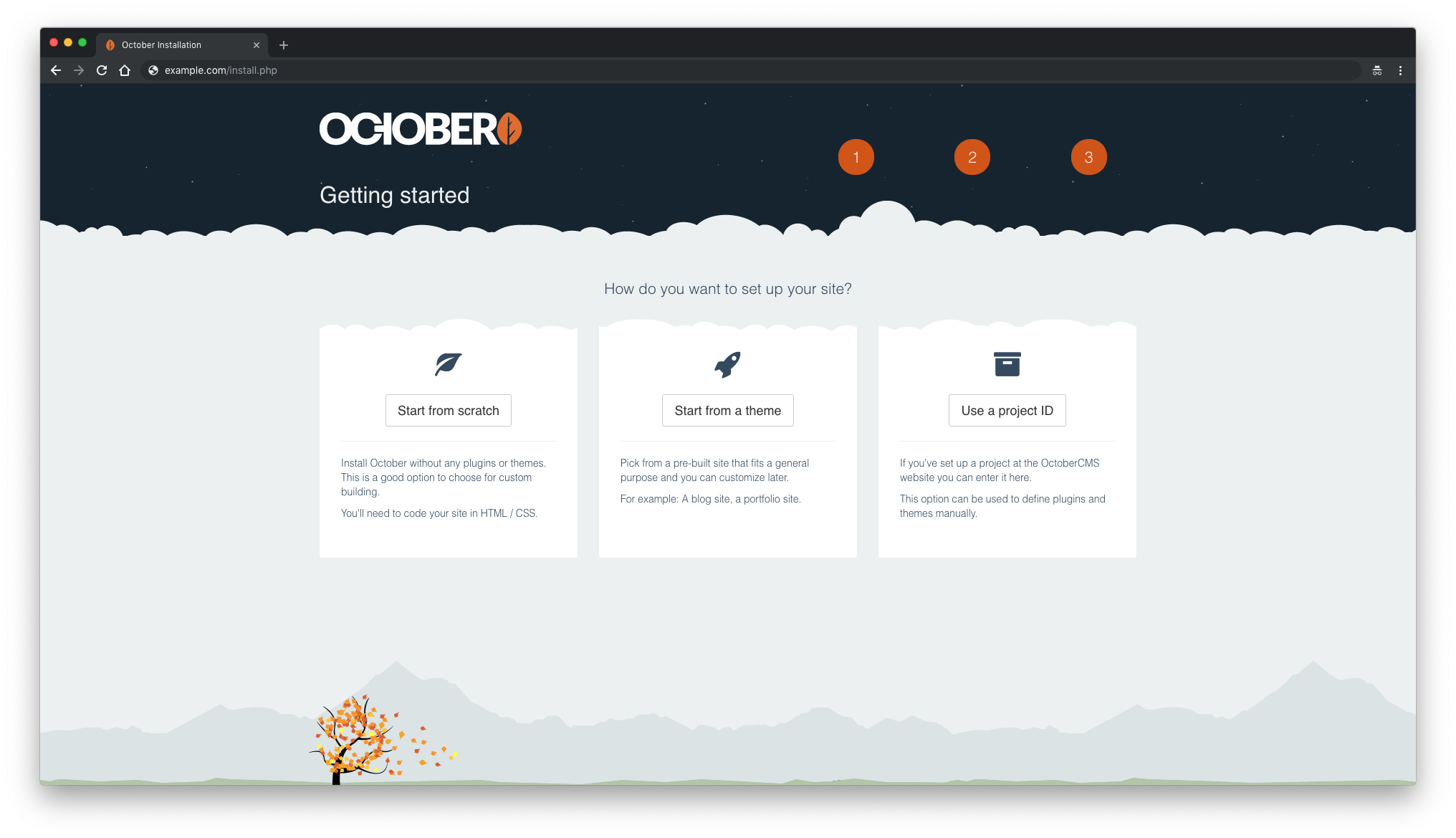October CMS is a robust, open-source, self-hosted CMS platform built on the Laravel PHP Framework. With its source code hosted on GitHub, October CMS is favored by many digital studios and freelancers worldwide for its simplicity, flexibility, and modern
design. In this tutorial, we’ll guide you through the installation of October CMS on a Fedora 29 system, using NGINX as the web server and MariaDB as the database server. You also have the option to secure your site with HTTPS using Let’s Encrypt certificates.
Requirements
Ensure your server meets these minimum requirements for hosting with October CMS:
- PHP version 7.0 or greater
- PHP PDO Extension
- cURL PHP Extension
- OpenSSL PHP Extension
- Mbstring PHP Library
- Zip PHP Library
- GD PHP Library
- XML PHP Extension
- JSON PHP Extension
- Apache with
mod_rewriteor NGINX
Prerequisites
- Fedora 29 system
- A non-root user with
sudoprivileges
Initial Steps
Verify your Fedora system version:
cat /etc/fedora-release # Fedora release 29 (Twenty Nine)
Configure the timezone:
timedatectl list-timezones sudo timedatectl set-timezone 'Region/City'
Update operating system packages:
sudo dnf upgrade -y
Install essential packages:
sudo dnf install -y vim wget curl git socat unzip bash-completion
Step 1 – Install PHP
To install PHP and necessary extensions:
sudo dnf install -y php-cli php-fpm php-pdo php-common php-mysqlnd php-curl php-json php-zip php-gd php-xml php-mbstring
Verify PHP installation:
php --version
Start and enable the PHP-FPM service:
sudo systemctl start php-fpm.service sudo systemctl enable php-fpm.service
Step 2 – Install MariaDB and Create a Database for October
Install MariaDB database server:
sudo dnf install -y mariadb-server
Verify MariaDB installation:
mysql --version
Start and enable MariaDB service:
sudo systemctl start mariadb.service sudo systemctl enable mariadb.service
Run the security script:
mysql_secure_installation
Create a database and user for October:
mysql -u root -p # Enter password CREATE DATABASE octobercms; GRANT ALL ON octobercms.* TO 'octoberuser' IDENTIFIED BY 'password'; FLUSH PRIVILEGES;
Exit the MariaDB shell:
quit
Step 3 – Install Acme.sh and Obtain Let’s Encrypt Certificate (Optional)
To enhance security, you can set up an SSL certificate. Use the Acme.sh client:
sudo mkdir /etc/letsencrypt
git clone https://github.com/Neilpang/acme.sh.git
cd acme.sh
sudo ./acme.sh --install --home /etc/letsencrypt --accountemail your_email@example.com
cd ~
Verify Acme.sh version:
/etc/letsencrypt/acme.sh --version
Acquire RSA and ECC/ECDSA certificates:
# RSA 2048
sudo /etc/letsencrypt/acme.sh --issue --standalone --home /etc/letsencrypt -d example.com --keylength 2048
# ECDSA
sudo /etc/letsencrypt/acme.sh --issue --standalone --home /etc/letsencrypt -d example.com --keylength ec-256
Step 4 – Install and Configure NGINX
Install NGINX:
sudo dnf install -y nginx
Verify NGINX installation:
nginx -v
Start and enable NGINX service:
sudo systemctl start nginx.service sudo systemctl enable nginx.service
Create NGINX configuration for October:
server {
listen [::]:443 ssl http2;
listen 443 ssl http2;
listen [::]:80;
listen 80;
server_name example.com;
index index.php index.html;
root /var/www/october;
ssl_certificate /etc/letsencrypt/example.com/fullchain.cer;
ssl_certificate_key /etc/letsencrypt/example.com/example.com.key;
ssl_certificate /etc/letsencrypt/example.com_ecc/fullchain.cer;
ssl_certificate_key /etc/letsencrypt/example.com_ecc/example.com.key;
location / {
try_files $uri /index.php$is_args$args;
}
location ~ \.php$ {
include default.d/php.conf;
include fastcgi_params;
fastcgi_pass unix:/run/php-fpm/www.sock;
fastcgi_param SCRIPT_FILENAME $document_root$fastcgi_script_name;
fastcgi_read_timeout 120s;
}
rewrite ^themes/.*/(layouts|pages|partials)/.*.htm /index.php break;
rewrite ^bootstrap/.* /index.php break;
rewrite ^config/.* /index.php break;
rewrite ^vendor/.* /index.php break;
rewrite ^storage/cms/.* /index.php break;
rewrite ^storage/logs/.* /index.php break;
rewrite ^storage/framework/.* /index.php break;
rewrite ^storage/temp/protected/.* /index.php break;
rewrite ^storage/app/uploads/protected/.* /index.php break;
}
Test the NGINX configuration:
sudo nginx -t
Reload NGINX:
sudo systemctl reload nginx.service
Step 5 – Download and Install October CMS
Create a document root directory:
sudo mkdir -p /var/www/october
Set ownership of the directory:
sudo chown -R [your_user]:[your_user] /var/www/october
Navigate to document root and download CMS:
cd /var/www/october wget http://octobercms.com/download -O october.zip
Unzip the installer:
unzip october.zip rm october.zip mv install-master/* .
Set NGINX ownership of the CMS directory:
sudo chown -R nginx:nginx /var/www/october
Edit PHP-FPM configuration:
sudo vim /etc/php-fpm.d/www.conf # user = nginx # group = nginx
Restart PHP-FPM:
sudo systemctl restart php-fpm.service
Finalize installation using your browser:
Visit http://example.com/install.php and follow the on-screen instructions.
Step 6 – Complete the October Setup
Ensure system checks are correct, then follow the setup wizard. Configure your database and admin user settings:

Set up advanced settings or proceed with defaults, then select how you want to set up your site:

To access the administration area, append /backend to your site URL.
For security, delete installation files:
sudo rm /var/www/october/install.php && sudo rm -rf /var/www/october/install_files
Links
FAQs
1. Why should I use October CMS?
October CMS delivers a straightforward and flexible way to build websites, leveraging the Laravel framework which is a robust PHP foundation. It is perfect for developers looking for a simple but powerful tool.
2. Can I install October CMS on a different OS?
Yes, although this guide is specific to Fedora 29, October CMS can be set up on any system that meets the minimum requirements, including different Linux distributions, Windows, and macOS systems.
3. Is SSL necessary for October CMS?
While not strictly necessary, enabling SSL is a recommended security best practice to protect data in transit between your server and users.
4. What do I do if I encounter errors during installation?
Ensure that all dependencies are installed correctly and check your PHP and NGINX configurations. The October CMS and Laravel communities are excellent resources for additional help.
